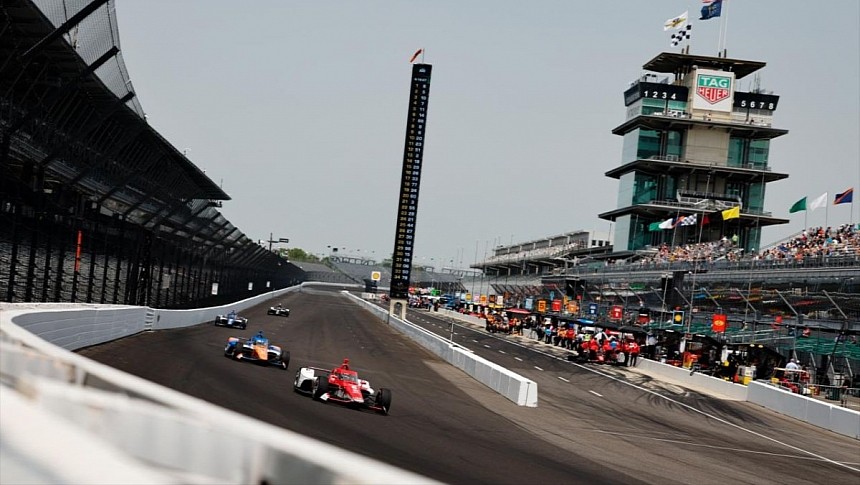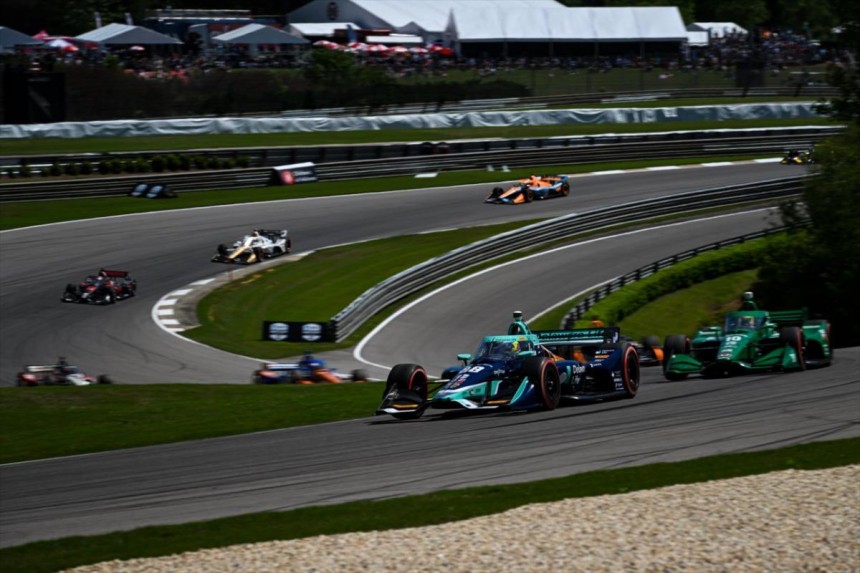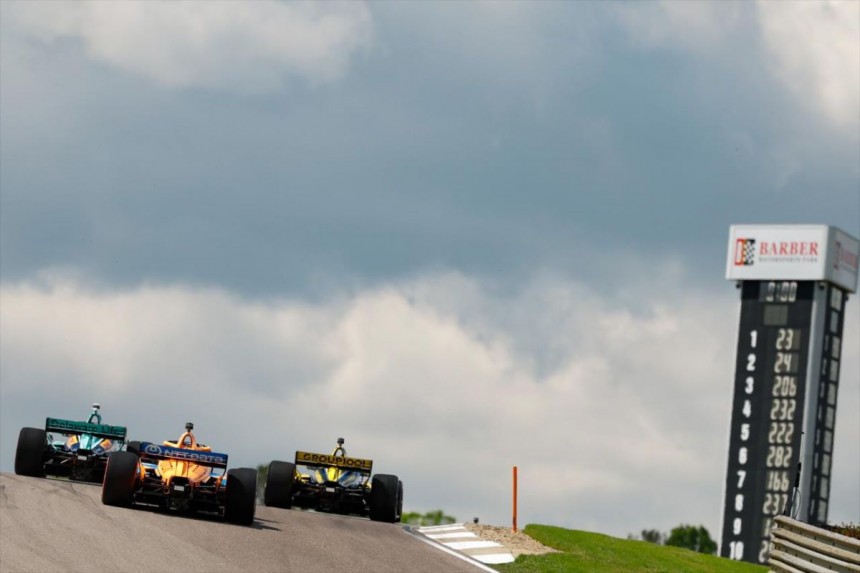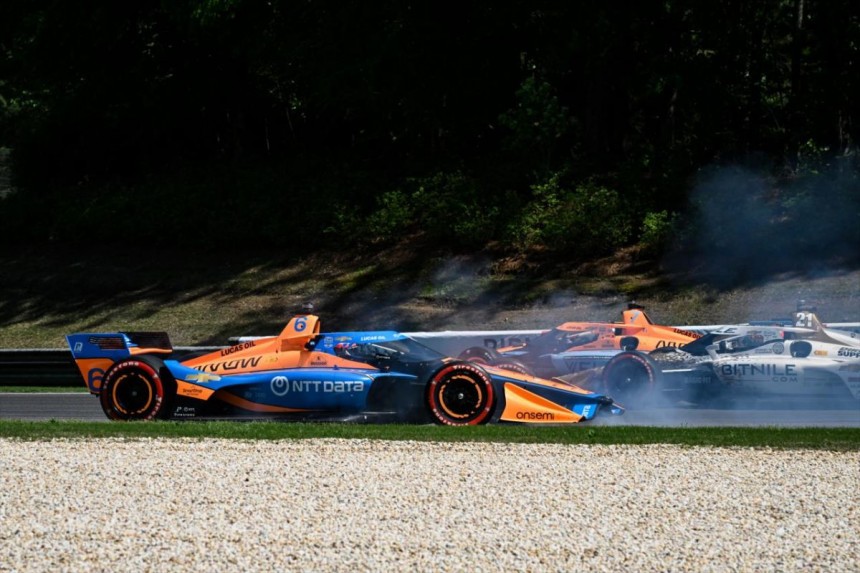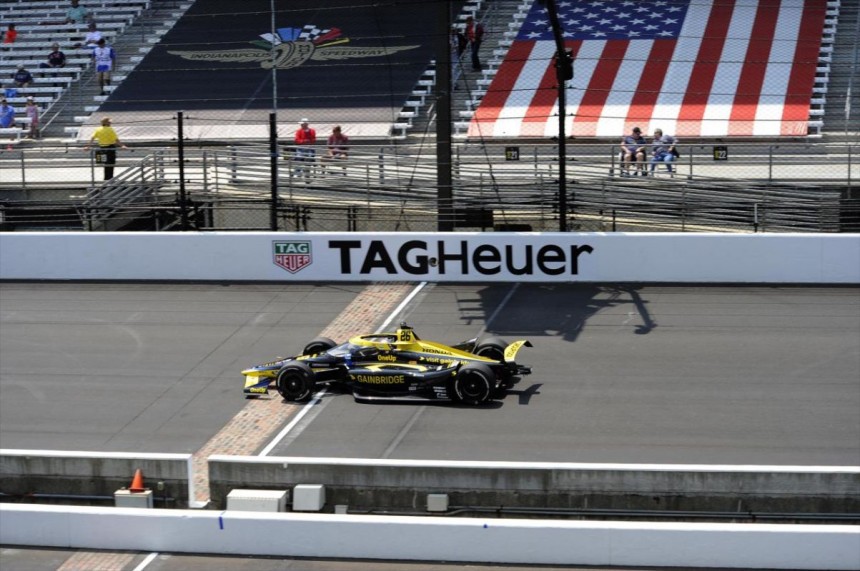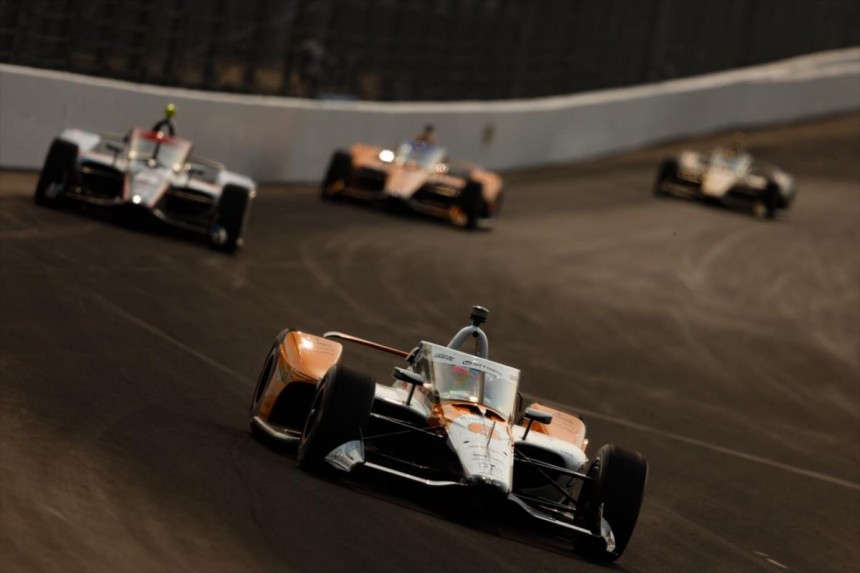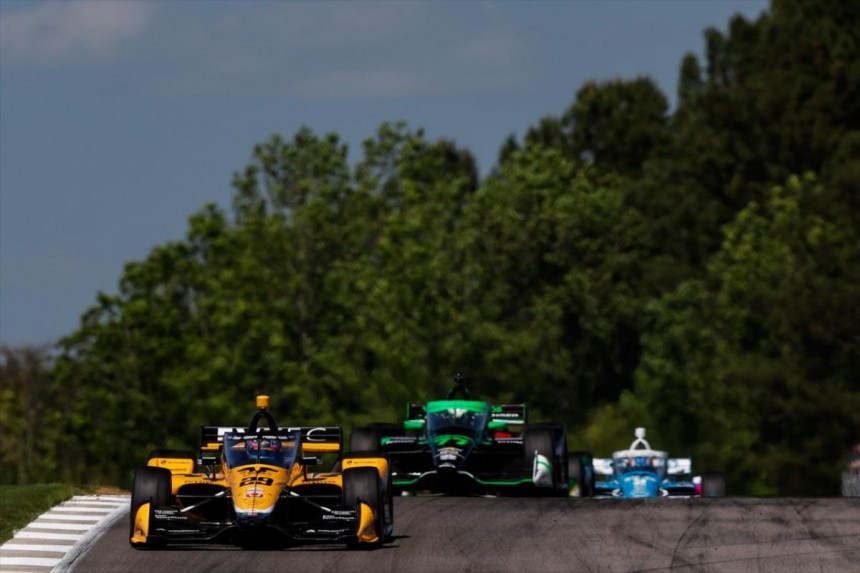Last week, Alex Palou confided that he doesn't believe his performance has altered much since the inaugural races of the season, attributing his recent successes to other racers' missteps more than his own efforts.
Fast-forward five days, and the evidence of this reality was on full display. The 26-year-old Spaniard navigated the midpoint of the season masterfully, boasting a sequence of commendable starts and finishes. He led a significant 42.3% of the 520 laps. His consistency shone brightly in Mid-Ohio, marking his eighth consecutive top-five finish of the season and his ninth top-ten in as many races. The tally reaches 24 top-five finishes in his last 42 races.
This consistent and strong performance is prompting rivals to push beyond their comfort zones in their attempts to catch up with him. For instance, Pato O'Ward was aware of Palou's blistering pace in the Mid-Ohio practice sessions. Driven by this knowledge, O'Ward pushed his vehicle to the limits during the Saturday afternoon qualifiers, resulting in a spin and a disappointing 25th position among the 27 cars. Josef Newgarden also strived to exceed his boundaries but only managed to qualify in the 15th position.
O'Ward and his team decided to deviate from the norm during the race with a three-stopper strategy. This decision didn't pan out as they'd hoped. Marcus Ericsson, who had started in the ninth position, went on the offensive from the get-go but ended up causing an accident with Felix Rosenqvist, resulting in his first DNF of the season.
Kyle Kirkwood's day ended with a spin at Turn 4, a consequence of a vigorous contest with Palou for the third spot. Furthermore, both Colton Herta and Graham Rahal had their share of misfortunes. The former was penalized for speeding on pit road, while the latter had a couple of slow pit stops. They were allowed the ever-consistent Palou to bask in the limelight on the weekend full of such blunders. The next race is set in Toronto, where Palou finished sixth as a rookie. However, his last two street races this season have resulted in a fifth and first-place finish.
While the tracks at Iowa and Gateway might pose challenges, Palou can lean on his victories at Indy Road, Portland, and Laguna Seca. Consequently, the championship seems to be his to lose.
At the dawn of May, Pato O'Ward was only three points behind, with Romain Grosjean lagging by 15 points. These drivers had consistently come in second in the first five races. But have they managed to maintain this performance in the last four races? Not even once
.
O'Ward entered the 2023 NTT INDYCAR SERIES season with high hopes. He had consistently been a close contender but could never dethrone Penske and Ganassi. To do so, and to be the first team since 2013 not named Penske or Ganassi, or not named Andretti since 2002, to win a title, O'Ward and Arrow McLaren Racing would need to bring more consistency to the track.
The young Mexican driver had shown promise with two victories in each of the last two seasons and nine podium finishes in the same period. But only half of his eight top-five finishes from the previous year resulted in podium finishes, which made a significant difference. O'Ward had a promising start to this year as well. Despite an engine issue while leading at St. Pete, he still managed to secure second place. He then followed this up with another second-place finish in Texas, establishing himself as a serious contender for the title.
However, he began making mistakes. O'Ward has had several mishaps over the past five races that might cost him the title. He had a poor strategic call in Long Beach, qualifying him sixth instead of potentially clinching the pole position. He tried to recover too quickly in the race, which ultimately led to a 17th-place finish.
He managed to rebound in Barber with a fourth-place finish and then another second-place at the GMR Grand Prix. Unfortunately, an overzealous move at the Indy 500 caused a crash that left him in 24th place, and a poor pit stop in Detroit resulted in another crash, relegating him to 26th.
While O'Ward was quick to blame Marcus Ericsson for the incident at Indy, he should have exercised more patience. Yes, O'Ward dropped from first to third on the opening lap of the restart, but it seemed like he pushed too hard to regain a position entering Turn 3. Despite sharing the same strategy as his top five teammates in Detroit, a pit stop issue left him a lap down. In a bid to pass Santino Ferrucci on the track, he collided with the concrete wall in Turn 9.
Over the last decade, the crown of the series championship has been perpetually split between the automotive titans of Penske and Ganassi. Now, as we reach the midway point of the season, it's looking increasingly likely that this legacy of success will continue undeterred.
Penske and Ganassi's domination is evident in the standings: an astounding six of the top seven drivers belong to these teams. Their show of force isn't limited to the standings; they've also roared to victory in eight of this year's nine races and a staggering 73.2% of races since the introduction of the Aeroscreen.
Revisiting the 2022 Indy 500, these two automotive juggernauts have claimed 81.8% of the last 22 races. Who will rise to challenge their reign? The stage for the next challenge is Toronto, a track where Penske and Ganassi have seized victory five times consecutively. Their prowess extends to street courses in general, having won seven of the last eight and 13 of the last 19 such races. The only challengers to break through their stronghold during this span have been Andretti Autosport (four wins) and Arrow McLaren Racing (one win).
The subsequent showdown is the Iowa doubleheader, where Penske has claimed victory number five of the last seven times. Penske's supremacy is equally evident on short ovals, with nine wins in the last 13 races since 2018. Standing as the leading figure among the drivers, Josef Newgarden has secured seven of those victories for Penske himself.
On short ovals, we may see a thrilling duel between Pato O'Ward and Josef Newgarden. These two have together claimed victory in seven of the last eight oval races. Newgarden alone has triumphed in six of these eight races and hasn't missed a beat this season, maintaining a perfect record. Newgarden and O'Ward have maintained an unbroken winning streak dating back to Race 2 at World Wide Technology Raceway in 2020, and they've also finished one-two in five of the last 12 oval races.
Following Iowa, the circuit moves to Nashville, where Ganassi boasts an undefeated record. From there, it's back to the Indy road course, where Ganassi celebrated a victory with Palou just this past May, and Penske has claimed three of the four return trip weekends.
Gateway is the next stop. Remember Penske's domination on short ovals? The concluding races take us westward to Portland and Laguna Seca. Ganassi claimed victory in Portland in 2021, with Penske following suit in 2022. Ganassi also won the Laguna Seca race last year. While Penske and Ganassi have forged a considerable gap ahead of their rivals, who will step up to join them? Statistically, Andretti has been next in line, but McLaren is showing promising signs of snatching the third spot.
In terms of victories this season, Chip Ganassi Racing leads the pack with five wins (Marcus Ericsson – St. Pete, Alex Palou – Indianapolis, Detroit, Road America, Mid-Ohio). Team Penske follows closely with three wins (Josef Newgarden – Texas, Indy 500, Scott McLaughlin – Barber), while Andretti Autosport has one win (Kyle Kirkwood – Long Beach) to their name.
The "Big 3" have won every series championship since 2003 and 87% (47-for-54) of the races in the Aeroscreen era. They also dominate the standings, with seven of the top ten drivers.
However, McLaren is gaining momentum. Despite only securing two victories in the last 34 races compared to Andretti's five, it's clear that a wave is building for McLaren. They currently boast two drivers in the top 8 in points, compared to Andretti's best rank of ninth. The four leading teams - Penske, Ganassi, Andretti, and McLaren - account for 12 of the top 13 spots in the standings.
These four Titans have carved out a league of their own in this era. From 2022 onwards, they have won all 27 races. Extending the scope to 2021, the win streak extends to 37 consecutive races. These four have claimed 94.7% (54-for-57) of victories in the Aeroscreen era (57 races).
The only outlier from the "Big 4" to taste victory was Meyer Shank Racing in 2021. These teams had a relatively dry Month of May, with Rinus VeeKay of Ed Carpenter Racing winning the GMR Grand Prix and Helio Castroneves claiming the Indy 500. RLL and Takuma Sato were the only other non "Big 4" team to win, seizing victory in the 2020 Indy 500. The divide is tangible: Penske and Ganassi at the top, followed by Andretti and McLaren, with the rest trailing behind. Penske has achieved 22 victories, Ganassi 21, Andretti seven, and McLaren four. The remaining teams - RLL, ECR, and MSR - have each claimed a solitary victory.
Despite the fierce competition, ratings have soared, and event attendance has neared maximum capacity. This was evident during the remarkable Month of May, culminating in Josef Newgarden narrowly edging out Marcus Ericsson in the fourth closest finish in the 107-year history of the Indianapolis 500. This phenomenal race was the highlight of a record-setting month at the Indianapolis Motor Speedway.
Newgarden's victory margin of .0974 seconds ranks only behind 1992 (.043 of a second), 2014 (.0600 of a second), and 2006 (.0635 of a second) races. In the entire history of the Indianapolis 500, this is only the third instance of the race being decided by a last-lap pass. The other instances occurred in 2006 and 2011.
In a sweet twist of fate, Newgarden, aged 32, repeated history by becoming the ninth driver to win the race at this age, the last time being in 2011. From a starting position of 17, Newgarden overtook 16 competitors to achieve his Indianapolis 500 victory. The win was further punctuated by unprecedented multi-time red flag conditions unrelated to weather.
The race was filled with thrilling moments and significant records.
Newgarden is the first American since Alexander Rossi in 2016 to have led for five laps. The only winners to have led fewer laps were Joe Dawson in 1912 (two laps) and Dan Wheldon in 2011 (one lap). The race also saw a record number of 11 lap leaders who finished on the lead lap, surpassing the previous record of 9 set in 2011. A total of 14 different drivers each led at least one lap, equalling the second-highest total in "500" history. The race had 52 lead changes, the third-highest total in "500" history. Six former winners led the 2023 Indianapolis 500, breaking the previous record of five set in 1980, 1981, and 1993. The six former winners were Marcus Ericsson, Ryan Hunter-Reay, Alexander Rossi, Takuma Sato, Will Power, and Helio Castroneves.
The excitement wasn't confined to race day. The previous weekend, Katherine Legge broke the record for the fastest female qualifier in Indianapolis 500 history with a speed of 231.070 mph. Agustin Canapino also made headlines by becoming the first Argentine driver to qualify for the Indianapolis 500 since Raul Riganti in 1940.
We saw Alex Palou, the first Spanish driver to win a pole for "The Greatest Spectacle in Racing," clock the fastest four-lap average speed in history for an Indianapolis 500 pole winner (234.217 mph). This year's event also set records for the fastest starting field and front row in Indianapolis 500 history.
The difference in time and speed between pole-sitter Alex Palou and No. 2 qualifier Rinus VeeKay is the closest in Indianapolis 500 history. Benjamin Pedersen also carved his name into the record books by achieving the fastest qualifying lap by a rookie in Indianapolis 500 history (233.297 mph). Moreover, 84 qualifying attempts were made on Saturday, May 21, setting a new all-time record. Aside from these groundbreaking records, there were numerous captivating stories, including the turnaround of Callum Ilott and Juncos Hollinger Racing's cars and Abel Motorsports qualifying as a first-time team. Indy had it all, and the event was capped off with a truly deserving winner.
This consistent and strong performance is prompting rivals to push beyond their comfort zones in their attempts to catch up with him. For instance, Pato O'Ward was aware of Palou's blistering pace in the Mid-Ohio practice sessions. Driven by this knowledge, O'Ward pushed his vehicle to the limits during the Saturday afternoon qualifiers, resulting in a spin and a disappointing 25th position among the 27 cars. Josef Newgarden also strived to exceed his boundaries but only managed to qualify in the 15th position.
O'Ward and his team decided to deviate from the norm during the race with a three-stopper strategy. This decision didn't pan out as they'd hoped. Marcus Ericsson, who had started in the ninth position, went on the offensive from the get-go but ended up causing an accident with Felix Rosenqvist, resulting in his first DNF of the season.
Kyle Kirkwood's day ended with a spin at Turn 4, a consequence of a vigorous contest with Palou for the third spot. Furthermore, both Colton Herta and Graham Rahal had their share of misfortunes. The former was penalized for speeding on pit road, while the latter had a couple of slow pit stops. They were allowed the ever-consistent Palou to bask in the limelight on the weekend full of such blunders. The next race is set in Toronto, where Palou finished sixth as a rookie. However, his last two street races this season have resulted in a fifth and first-place finish.
While the tracks at Iowa and Gateway might pose challenges, Palou can lean on his victories at Indy Road, Portland, and Laguna Seca. Consequently, the championship seems to be his to lose.
.
O'Ward entered the 2023 NTT INDYCAR SERIES season with high hopes. He had consistently been a close contender but could never dethrone Penske and Ganassi. To do so, and to be the first team since 2013 not named Penske or Ganassi, or not named Andretti since 2002, to win a title, O'Ward and Arrow McLaren Racing would need to bring more consistency to the track.
The young Mexican driver had shown promise with two victories in each of the last two seasons and nine podium finishes in the same period. But only half of his eight top-five finishes from the previous year resulted in podium finishes, which made a significant difference. O'Ward had a promising start to this year as well. Despite an engine issue while leading at St. Pete, he still managed to secure second place. He then followed this up with another second-place finish in Texas, establishing himself as a serious contender for the title.
However, he began making mistakes. O'Ward has had several mishaps over the past five races that might cost him the title. He had a poor strategic call in Long Beach, qualifying him sixth instead of potentially clinching the pole position. He tried to recover too quickly in the race, which ultimately led to a 17th-place finish.
While O'Ward was quick to blame Marcus Ericsson for the incident at Indy, he should have exercised more patience. Yes, O'Ward dropped from first to third on the opening lap of the restart, but it seemed like he pushed too hard to regain a position entering Turn 3. Despite sharing the same strategy as his top five teammates in Detroit, a pit stop issue left him a lap down. In a bid to pass Santino Ferrucci on the track, he collided with the concrete wall in Turn 9.
Over the last decade, the crown of the series championship has been perpetually split between the automotive titans of Penske and Ganassi. Now, as we reach the midway point of the season, it's looking increasingly likely that this legacy of success will continue undeterred.
Penske and Ganassi's domination is evident in the standings: an astounding six of the top seven drivers belong to these teams. Their show of force isn't limited to the standings; they've also roared to victory in eight of this year's nine races and a staggering 73.2% of races since the introduction of the Aeroscreen.
The subsequent showdown is the Iowa doubleheader, where Penske has claimed victory number five of the last seven times. Penske's supremacy is equally evident on short ovals, with nine wins in the last 13 races since 2018. Standing as the leading figure among the drivers, Josef Newgarden has secured seven of those victories for Penske himself.
On short ovals, we may see a thrilling duel between Pato O'Ward and Josef Newgarden. These two have together claimed victory in seven of the last eight oval races. Newgarden alone has triumphed in six of these eight races and hasn't missed a beat this season, maintaining a perfect record. Newgarden and O'Ward have maintained an unbroken winning streak dating back to Race 2 at World Wide Technology Raceway in 2020, and they've also finished one-two in five of the last 12 oval races.
Following Iowa, the circuit moves to Nashville, where Ganassi boasts an undefeated record. From there, it's back to the Indy road course, where Ganassi celebrated a victory with Palou just this past May, and Penske has claimed three of the four return trip weekends.
In terms of victories this season, Chip Ganassi Racing leads the pack with five wins (Marcus Ericsson – St. Pete, Alex Palou – Indianapolis, Detroit, Road America, Mid-Ohio). Team Penske follows closely with three wins (Josef Newgarden – Texas, Indy 500, Scott McLaughlin – Barber), while Andretti Autosport has one win (Kyle Kirkwood – Long Beach) to their name.
The "Big 3" have won every series championship since 2003 and 87% (47-for-54) of the races in the Aeroscreen era. They also dominate the standings, with seven of the top ten drivers.
However, McLaren is gaining momentum. Despite only securing two victories in the last 34 races compared to Andretti's five, it's clear that a wave is building for McLaren. They currently boast two drivers in the top 8 in points, compared to Andretti's best rank of ninth. The four leading teams - Penske, Ganassi, Andretti, and McLaren - account for 12 of the top 13 spots in the standings.
These four Titans have carved out a league of their own in this era. From 2022 onwards, they have won all 27 races. Extending the scope to 2021, the win streak extends to 37 consecutive races. These four have claimed 94.7% (54-for-57) of victories in the Aeroscreen era (57 races).
Despite the fierce competition, ratings have soared, and event attendance has neared maximum capacity. This was evident during the remarkable Month of May, culminating in Josef Newgarden narrowly edging out Marcus Ericsson in the fourth closest finish in the 107-year history of the Indianapolis 500. This phenomenal race was the highlight of a record-setting month at the Indianapolis Motor Speedway.
Newgarden's victory margin of .0974 seconds ranks only behind 1992 (.043 of a second), 2014 (.0600 of a second), and 2006 (.0635 of a second) races. In the entire history of the Indianapolis 500, this is only the third instance of the race being decided by a last-lap pass. The other instances occurred in 2006 and 2011.
In a sweet twist of fate, Newgarden, aged 32, repeated history by becoming the ninth driver to win the race at this age, the last time being in 2011. From a starting position of 17, Newgarden overtook 16 competitors to achieve his Indianapolis 500 victory. The win was further punctuated by unprecedented multi-time red flag conditions unrelated to weather.
The race was filled with thrilling moments and significant records.
The excitement wasn't confined to race day. The previous weekend, Katherine Legge broke the record for the fastest female qualifier in Indianapolis 500 history with a speed of 231.070 mph. Agustin Canapino also made headlines by becoming the first Argentine driver to qualify for the Indianapolis 500 since Raul Riganti in 1940.
We saw Alex Palou, the first Spanish driver to win a pole for "The Greatest Spectacle in Racing," clock the fastest four-lap average speed in history for an Indianapolis 500 pole winner (234.217 mph). This year's event also set records for the fastest starting field and front row in Indianapolis 500 history.
The difference in time and speed between pole-sitter Alex Palou and No. 2 qualifier Rinus VeeKay is the closest in Indianapolis 500 history. Benjamin Pedersen also carved his name into the record books by achieving the fastest qualifying lap by a rookie in Indianapolis 500 history (233.297 mph). Moreover, 84 qualifying attempts were made on Saturday, May 21, setting a new all-time record. Aside from these groundbreaking records, there were numerous captivating stories, including the turnaround of Callum Ilott and Juncos Hollinger Racing's cars and Abel Motorsports qualifying as a first-time team. Indy had it all, and the event was capped off with a truly deserving winner.
